
Leadtek WinFast A400 GT TDG
Written by John Yan on 7/21/2004 for
PC
More On:
Leadtek WinFast A400 GT TDG
The GeForce 6800 cards are hitting the market and we’re fortunate to be able to get our hands on a production card from Leadtek. Our first look at a GeForce 6800 card will be the Leadtek WinFast A400 GT TDH. It’s the middle of the road GeForce 6800 card and we’ll pit it against the Radeon X800 Pro to see how well NVIDIA’s offering is.

This is a stock pic from Leadtek. My camera died so I didn't have another digital camera to take a picture. The picture that Leadtek gave me seems to be the Ultra version here and not the GT version as it has two molex connectors and two DVI connectors.
Built on a 0.13 micron process, the WinFast A400 GT TDG is the GeForce 6800 GT variant from Leadtek. The Geforce 6800 GT features 16 pipelines and runs at 350MHz core speed and 500MHz memory speed. The card comes with 256MB of GDDR3 memory. Speed differences between the Ultra and Extreme versions are 50MHz on clock and memory per step up.
Leadtek’s design features their mesh screen fan that can get clogged up easily in dusty environments. You either like it or you don’t. I haven’t had many problems with my Leadtek cards with this grill but I am probably in the minority on this one as I’ve read many posts on this situation. The card also features a larger copper heatsink that does make this card take up two slots whereas the reference GeForce 6800 GT only takes up one slot. Because of this, placement in Shuttle cases is out of the question. Then again, would the Shuttle power supply be able to power this card? I don’t have a Shuttle system to test it so I wouldn’t know for sure. If not, then the case would be a moot point. For normal case users, some will care and some will not. Leadteak’s larger design does allow them to use a larger yet slower fan to try and decrease the noise level. Leadtek’s box states that the design allows for less than 30Db of sound so we’ll see if the larger cooling solution produces less sound.
Unlike the Ultra version, the GT version only requires and is outfitted with one molex connector. A 300-watt power supply is recommended for this card. Since we’ll be using a Zalman 400-watt power supply to test the card, we shouldn’t have any problems with power requirements. Also unlike the Ultra reference card, there’s only one DVI connector.
Tech wise, the GeForce 6800 is the only card currently that supports Pixel Shader 3.0. It’s been highly touted by NVIDIA and the patch to show off the power of Pixel Shader 3.0 in Far Cry should be out soon. Future games will probably start taking advantage of the technology and right now, only NVIDIA 6800 cards support it.
Leadtek’s got a decent bundle with this card including two great games in Splinter Cell : Pandora Tomorrow and Prince of Persia: Sands of Time. The other two games, Gun Metal and Big Mutha Trucker aren’t really anything to write about. But, the first two are very fun to play and great additions to your library.
Plugging the card into my system, I was happy to find that the fan was rather quiet even when playing games. It was hardly noticeable and I applaud Leadtek for trying to make a quieter card. I did have an issue if the card was parallel to the ground, like in some tower cases, there was a loud grinding sound as if the fan is hitting a wire. Leadtek assured me that this was not an issue with the other boards they have so I’ll attribute this to a shipping defect. Placing my tower on the side allowed for quiet operation. (Update - I seem to have fixed the problem by jiggling the card's heating unit a little bit. It's all quiet now when standing up.)
To test the card, I ran it in this system against a Sapphire X800 Pro.
AMD64 3200+
ABIT KT8-Max3
2 Crucial PC3200 256-MB sticks
Maxtor 120GIG 7200RPM HD
Windows XP Professional w/ Service Pack 1
NVIDIA Forceware 61.45 drivers

Our first benchmark is 3DMark 2001 SE and it’s one of two synthetic benchmarks we will use in this test.
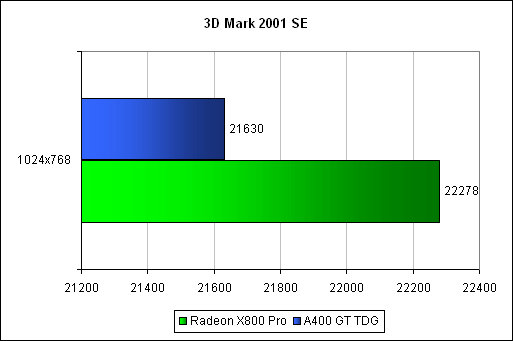
The X800 Pro pulled ahead a little here over the NVIDIA card. Let’s see how it fares up in the next synthetic test.

Aquamark is our final synthetic test that we ran with the two cards. Test was conducted at 1024x768x32.
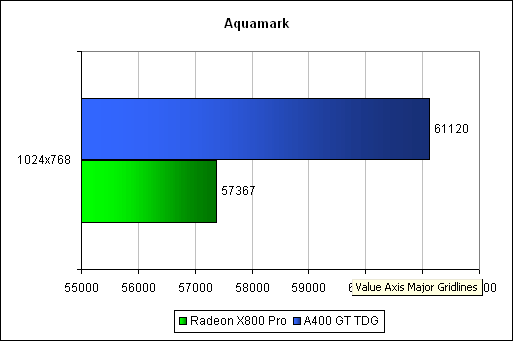
With a score of 61,120 aquamarks, the WinFast A400GT TDG pulls ahead of the X800 Pro. Now that we’ve seen what the card can do in two synthetic tests, let’s take it to real world applications.

First up is good old Halo: Combat Evolved. The shooter from Microsoft was tested in three different resolutions with Pixel Shader 2.0 and using the default demo. Here are the results.
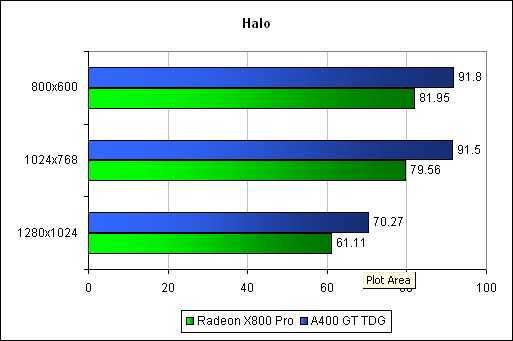
In all resolutions, the WinFast A400GT TDG pulls ahead of the X800 Pro The card runs Halo very well on an average fps scale giving you good performance and running 9+ fps faster than the same priced ATI card.

Splinter Cell is our next test. The NVIDIA card’s doing well so far against the competition. Let’s see if it can keep outpacing the ATI card.
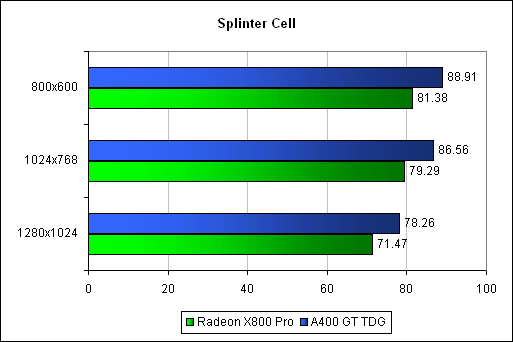
Again, the WinFast A400GT TDG runs the game faster than the X800 Pro. This time around, the card is faster in all three resolutions by 7+ fps.

Unreal Tournament 2004 gets into the act as we phase out Unreal Tournament 2003. The two games are built upon similar technology though. Tests were taken with three demos of botmatches and then the three scores were averaged together. Details were turned to their highest levels.
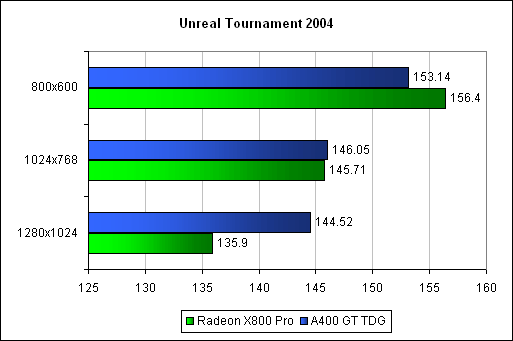
Here we see the two cards close in performance initially but the WinFast A400 GT TDG starts to pull ahead the higher we go in resolution.

Finally, Far Cry is another new title we’’ve started using the bench systems and cards. I’ve been playing this game a lot the past few weeks and really enjoy it. Details were set to maximum as we ran the tests. The demo used was the one included in the game.
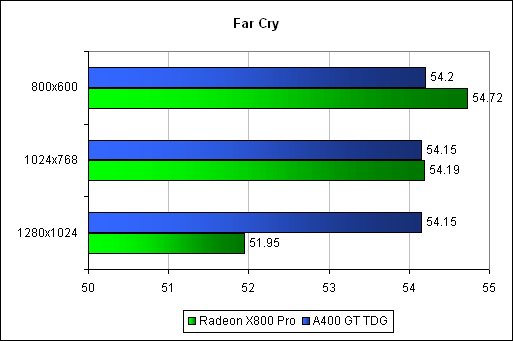
Interestingly enough, the three resolutions ran close to the same speed on the NVIDIA card and close to the X800 Pro until it pulls slightly ahead when we crank up the resolution to 1280x1024.
Now that we’ve seen what it can do without any special features turned on, lets’ start upping the anti-aliasing and anisotropic filtering to see how it does in the various resolutions and how the WinFast A400 GT TDG compares to the X800 Pro.
For a range of resolutions we started out with features turned off, then went to 4X anti-aliasing with 4X anisotropic filtering to 6X anti-aliasing and 16X anisotropic filtering on the ATI card while we jacked the NVIDIA anti-aliasing to 8X. The two games we tested in this test were Far Cry, and Unreal Tournament 2004.
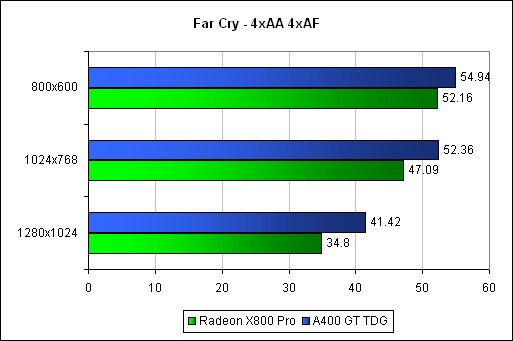
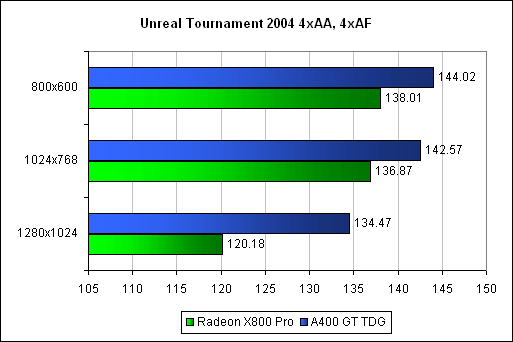
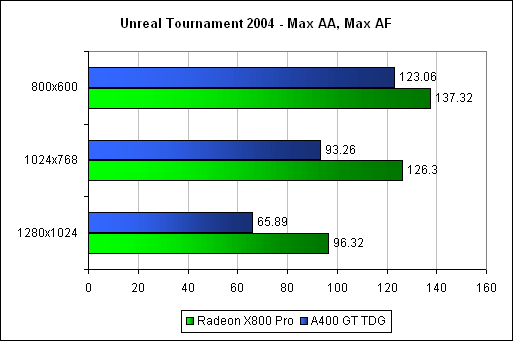
Showing off a little more muscle than the X800 Pro in Far Cry,the WinFast A400 GT TDG card continues to hold the lead even with the image quality settings turned on through various levels. (Update - I re-ran the Far Cry tests trying to increase the anti-aliasing over 6X to the NVIDIA max of 8X but it doesn't seem to do any good. So, I will exclude the max comparison on this card.)
The different max settings for anisotropic filtering and anti-aliasing shows in the results of Unreal Tournament 2004 as the ATI card only go up to is 6X in anti-aliasing. Even so, the GeForce 6800 GT runs the game pretty fast at the max settings.
NVIDIA’s got a good card on their hands. While Leadtek didn’t do anything special with this card such as adding VIVO features, the technology and price comparison makes this card hard to pass up when comparing to the ATI X800 Pro, which is priced similarly. The dual slot requirement might turn off potential buyers to other company’s that sell the GeForce 6800 card. But the card does run quiet as I had to listen really hard to hear the fan running. I’m definitely impressed with NVIDIA’s latest offering and it should give ATI a run for their money. The WinFast A400 GT TDG is a solid NVIDIA card one that you should consider if you are looking for a quiet GT offering.

This is a stock pic from Leadtek. My camera died so I didn't have another digital camera to take a picture. The picture that Leadtek gave me seems to be the Ultra version here and not the GT version as it has two molex connectors and two DVI connectors.
Built on a 0.13 micron process, the WinFast A400 GT TDG is the GeForce 6800 GT variant from Leadtek. The Geforce 6800 GT features 16 pipelines and runs at 350MHz core speed and 500MHz memory speed. The card comes with 256MB of GDDR3 memory. Speed differences between the Ultra and Extreme versions are 50MHz on clock and memory per step up.
Leadtek’s design features their mesh screen fan that can get clogged up easily in dusty environments. You either like it or you don’t. I haven’t had many problems with my Leadtek cards with this grill but I am probably in the minority on this one as I’ve read many posts on this situation. The card also features a larger copper heatsink that does make this card take up two slots whereas the reference GeForce 6800 GT only takes up one slot. Because of this, placement in Shuttle cases is out of the question. Then again, would the Shuttle power supply be able to power this card? I don’t have a Shuttle system to test it so I wouldn’t know for sure. If not, then the case would be a moot point. For normal case users, some will care and some will not. Leadteak’s larger design does allow them to use a larger yet slower fan to try and decrease the noise level. Leadtek’s box states that the design allows for less than 30Db of sound so we’ll see if the larger cooling solution produces less sound.
Unlike the Ultra version, the GT version only requires and is outfitted with one molex connector. A 300-watt power supply is recommended for this card. Since we’ll be using a Zalman 400-watt power supply to test the card, we shouldn’t have any problems with power requirements. Also unlike the Ultra reference card, there’s only one DVI connector.
Tech wise, the GeForce 6800 is the only card currently that supports Pixel Shader 3.0. It’s been highly touted by NVIDIA and the patch to show off the power of Pixel Shader 3.0 in Far Cry should be out soon. Future games will probably start taking advantage of the technology and right now, only NVIDIA 6800 cards support it.
Leadtek’s got a decent bundle with this card including two great games in Splinter Cell : Pandora Tomorrow and Prince of Persia: Sands of Time. The other two games, Gun Metal and Big Mutha Trucker aren’t really anything to write about. But, the first two are very fun to play and great additions to your library.
Plugging the card into my system, I was happy to find that the fan was rather quiet even when playing games. It was hardly noticeable and I applaud Leadtek for trying to make a quieter card. I did have an issue if the card was parallel to the ground, like in some tower cases, there was a loud grinding sound as if the fan is hitting a wire. Leadtek assured me that this was not an issue with the other boards they have so I’ll attribute this to a shipping defect. Placing my tower on the side allowed for quiet operation. (Update - I seem to have fixed the problem by jiggling the card's heating unit a little bit. It's all quiet now when standing up.)
To test the card, I ran it in this system against a Sapphire X800 Pro.
AMD64 3200+
ABIT KT8-Max3
2 Crucial PC3200 256-MB sticks
Maxtor 120GIG 7200RPM HD
Windows XP Professional w/ Service Pack 1
NVIDIA Forceware 61.45 drivers

Our first benchmark is 3DMark 2001 SE and it’s one of two synthetic benchmarks we will use in this test.

The X800 Pro pulled ahead a little here over the NVIDIA card. Let’s see how it fares up in the next synthetic test.

Aquamark is our final synthetic test that we ran with the two cards. Test was conducted at 1024x768x32.

With a score of 61,120 aquamarks, the WinFast A400GT TDG pulls ahead of the X800 Pro. Now that we’ve seen what the card can do in two synthetic tests, let’s take it to real world applications.

First up is good old Halo: Combat Evolved. The shooter from Microsoft was tested in three different resolutions with Pixel Shader 2.0 and using the default demo. Here are the results.

In all resolutions, the WinFast A400GT TDG pulls ahead of the X800 Pro The card runs Halo very well on an average fps scale giving you good performance and running 9+ fps faster than the same priced ATI card.

Splinter Cell is our next test. The NVIDIA card’s doing well so far against the competition. Let’s see if it can keep outpacing the ATI card.

Again, the WinFast A400GT TDG runs the game faster than the X800 Pro. This time around, the card is faster in all three resolutions by 7+ fps.

Unreal Tournament 2004 gets into the act as we phase out Unreal Tournament 2003. The two games are built upon similar technology though. Tests were taken with three demos of botmatches and then the three scores were averaged together. Details were turned to their highest levels.

Here we see the two cards close in performance initially but the WinFast A400 GT TDG starts to pull ahead the higher we go in resolution.

Finally, Far Cry is another new title we’’ve started using the bench systems and cards. I’ve been playing this game a lot the past few weeks and really enjoy it. Details were set to maximum as we ran the tests. The demo used was the one included in the game.

Interestingly enough, the three resolutions ran close to the same speed on the NVIDIA card and close to the X800 Pro until it pulls slightly ahead when we crank up the resolution to 1280x1024.
Now that we’ve seen what it can do without any special features turned on, lets’ start upping the anti-aliasing and anisotropic filtering to see how it does in the various resolutions and how the WinFast A400 GT TDG compares to the X800 Pro.
For a range of resolutions we started out with features turned off, then went to 4X anti-aliasing with 4X anisotropic filtering to 6X anti-aliasing and 16X anisotropic filtering on the ATI card while we jacked the NVIDIA anti-aliasing to 8X. The two games we tested in this test were Far Cry, and Unreal Tournament 2004.



Showing off a little more muscle than the X800 Pro in Far Cry,the WinFast A400 GT TDG card continues to hold the lead even with the image quality settings turned on through various levels. (Update - I re-ran the Far Cry tests trying to increase the anti-aliasing over 6X to the NVIDIA max of 8X but it doesn't seem to do any good. So, I will exclude the max comparison on this card.)
The different max settings for anisotropic filtering and anti-aliasing shows in the results of Unreal Tournament 2004 as the ATI card only go up to is 6X in anti-aliasing. Even so, the GeForce 6800 GT runs the game pretty fast at the max settings.
NVIDIA’s got a good card on their hands. While Leadtek didn’t do anything special with this card such as adding VIVO features, the technology and price comparison makes this card hard to pass up when comparing to the ATI X800 Pro, which is priced similarly. The dual slot requirement might turn off potential buyers to other company’s that sell the GeForce 6800 card. But the card does run quiet as I had to listen really hard to hear the fan running. I’m definitely impressed with NVIDIA’s latest offering and it should give ATI a run for their money. The WinFast A400 GT TDG is a solid NVIDIA card one that you should consider if you are looking for a quiet GT offering.
A very nice card by NVIDIA and Leadtek, but no extras over the reference other than the different cooling option. I would've liked the VIVO features that Leadtek is known to put into their cards.
Rating: 8.9 Class Leading
* The product in this article was sent to us by the developer/company.

About Author
I've been reviewing products since 1997 and started out at Gaming Nexus. As one of the original writers, I was tapped to do action games and hardware. Nowadays, I work with a great group of folks on here to bring to you news and reviews on all things PC and consoles.
As for what I enjoy, I love action and survival games. I'm more of a PC gamer now than I used to be, but still enjoy the occasional console fair. Lately, I've been really playing a ton of retro games after building an arcade cabinet for myself and the kids. There's some old games I love to revisit and the cabinet really does a great job at bringing back that nostalgic feeling of going to the arcade.
View Profile